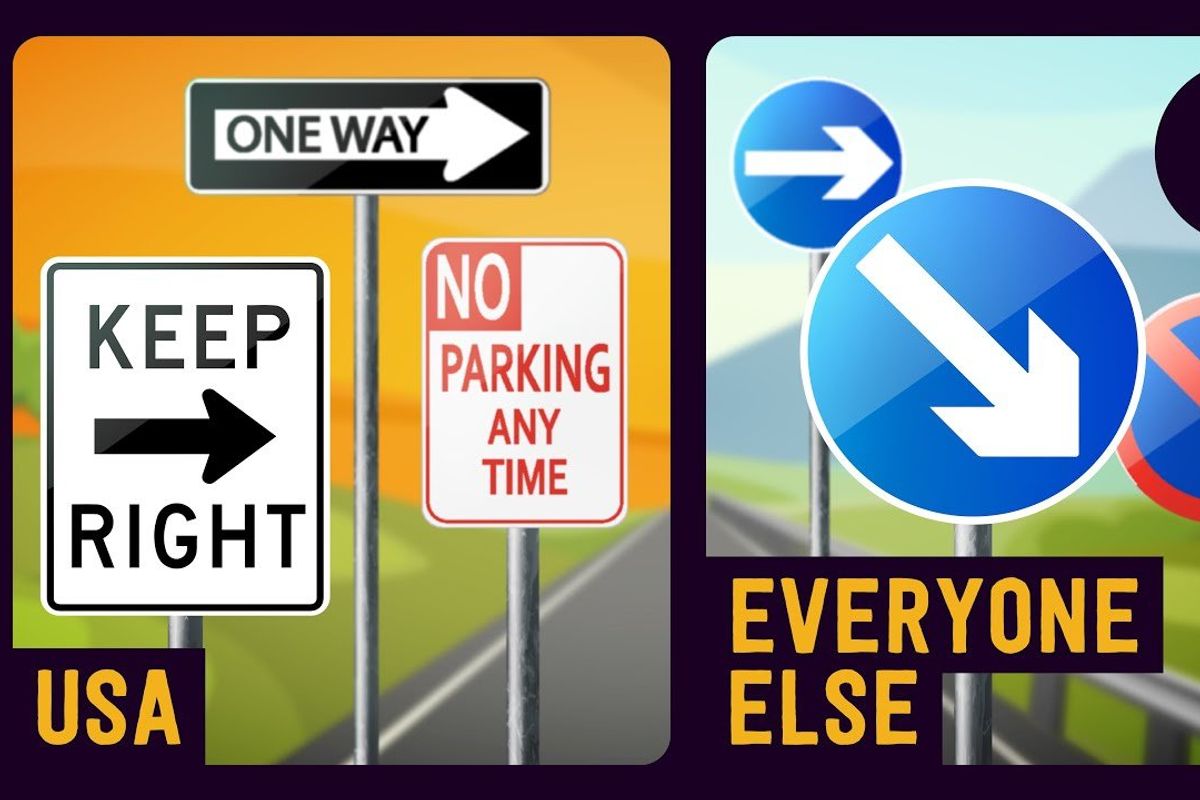Why America's traffic signs look so much different from the rest of the world
American exceptionalism had a lot to do with it.

Why are traffic signs so differnt in the U.S.?
Have you ever watched a James Bond movie and noticed that as he races his Astin Martin through the hills of an exotic European locale, the street signs look a lot different than those in America? Did you also notice that they don’t have many words, mostly shapes and pictures?
It isn’t by accident. Many years ago, there was a movement to get America on board with the rest of the world so all of our street signs would be the same, but it never happened. For better or worse, America, once again, exercised its independent spirit and stuck with its signs.
The whole story was recently told on YouTube by Half as Interesting. This channel prides itself on being an “Education-y explainer videos that are almost good enough to watch.”
The chasm between the U.S. and the rest of the world regarding traffic signs started in the early 1900s when Henry Ford began mass-producing automobiles and America quickly became the car capital of the world.
This also made the U.S. the road capital of the world.
Why US Signs Look Different Than The Rest Of The World’s
The signage across the U.S. in the early days of the automobile was inconsistent, which would cause problems as people drove from region to region and couldn’t make sense of the signage. So, in 1931, a committee of traffic sign organizations created a joint committee that ultimately came up with the 1931 Manual on Uniform Traffic Control Devices.
This Bible of signage gave us the stop sign we all know and love, along with the iconic “One Way” and “Railroad Crossing” signs that are still used today.
As the rest of the world caught up to the U.S., the United Nations attempted to get the world on the same page regarding traffic signs, but the U.S. wouldn’t go along. “It turned out that Americans, still riding the intoxicating high of World War II propaganda and American exceptionalism, did not look kindly on European triangles telling them how to drive,” the video says.
In 1968, the Vienna Convention on Road Signs & Signals created a universal road sign system joined by 69 countries, and today, it governs the road signs seen in most of the world. The United States refused to sign the agreement. Why? Half as Interesting cites 3 big reasons.
“Technically, legally, roads are under the purview of the states, not the federal government and so the federal government signing a treaty telling them how to handle their roads is a bit legally murky, the video says.
“Second, at the time of the treaty, the US was working on the Interstate highway system, which they felt would require a lot of breathless, fast-paced innovation in the rough and tumble world of roadside signage and they didn't want to be bogged down by the strictures of a treaty,” the video continues. “Third, given that the US had the most robust driving history in the world, Americans were pretty much their existing signs and they didn't much want them to change.”
If the UN figured out how to tell the British to drive on the other side of the road, Americans could get a rental car in London.
.





 Rihanna Nails GIF
Rihanna Nails GIF

 Good luck trying to catch a gazelle.
Good luck trying to catch a gazelle. Chickens will eat just about anything.
Chickens will eat just about anything. There's actually a big difference between horses and zebras besides just the stripes.
There's actually a big difference between horses and zebras besides just the stripes. Stop Right There The End GIF by Freeform
Stop Right There The End GIF by Freeform